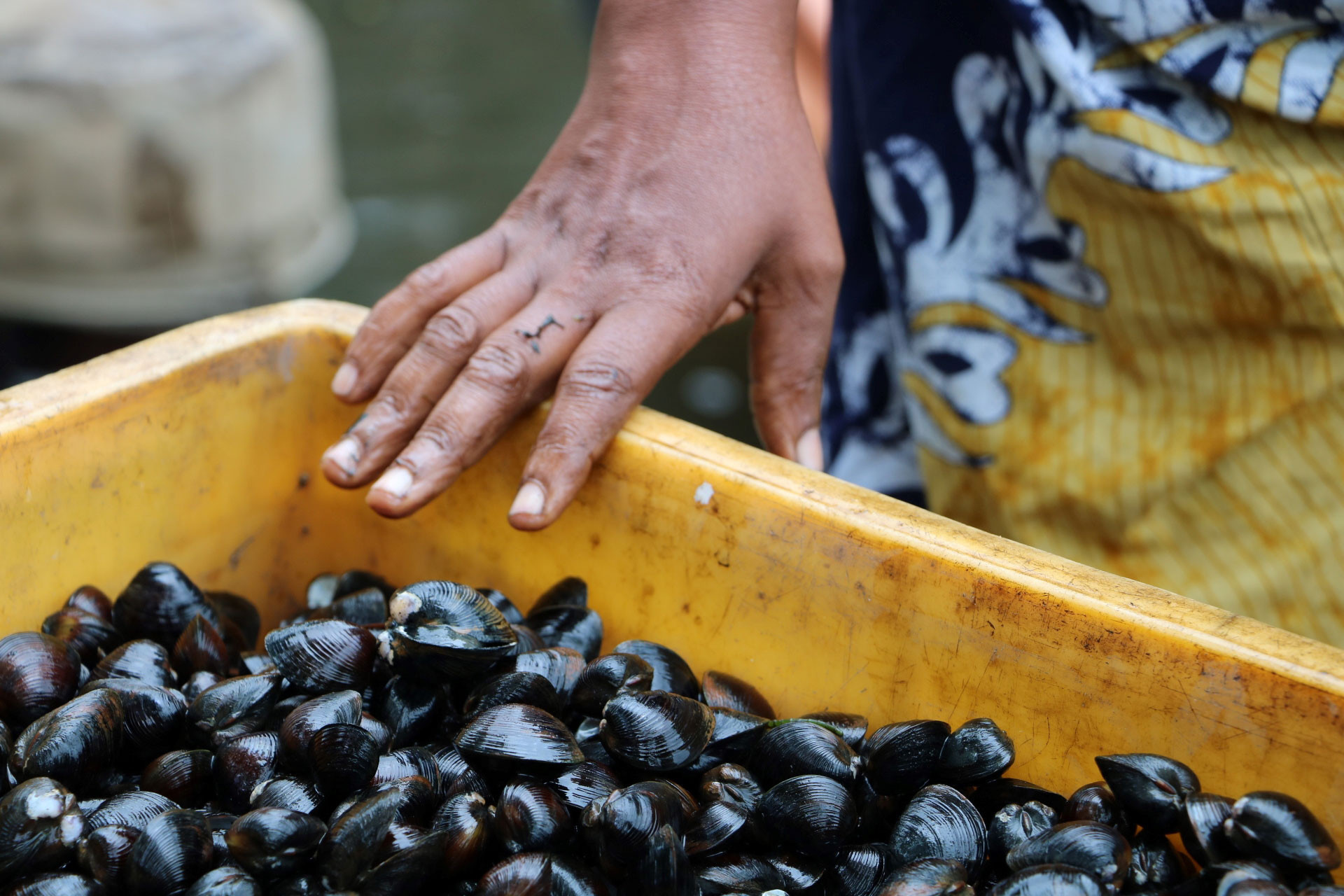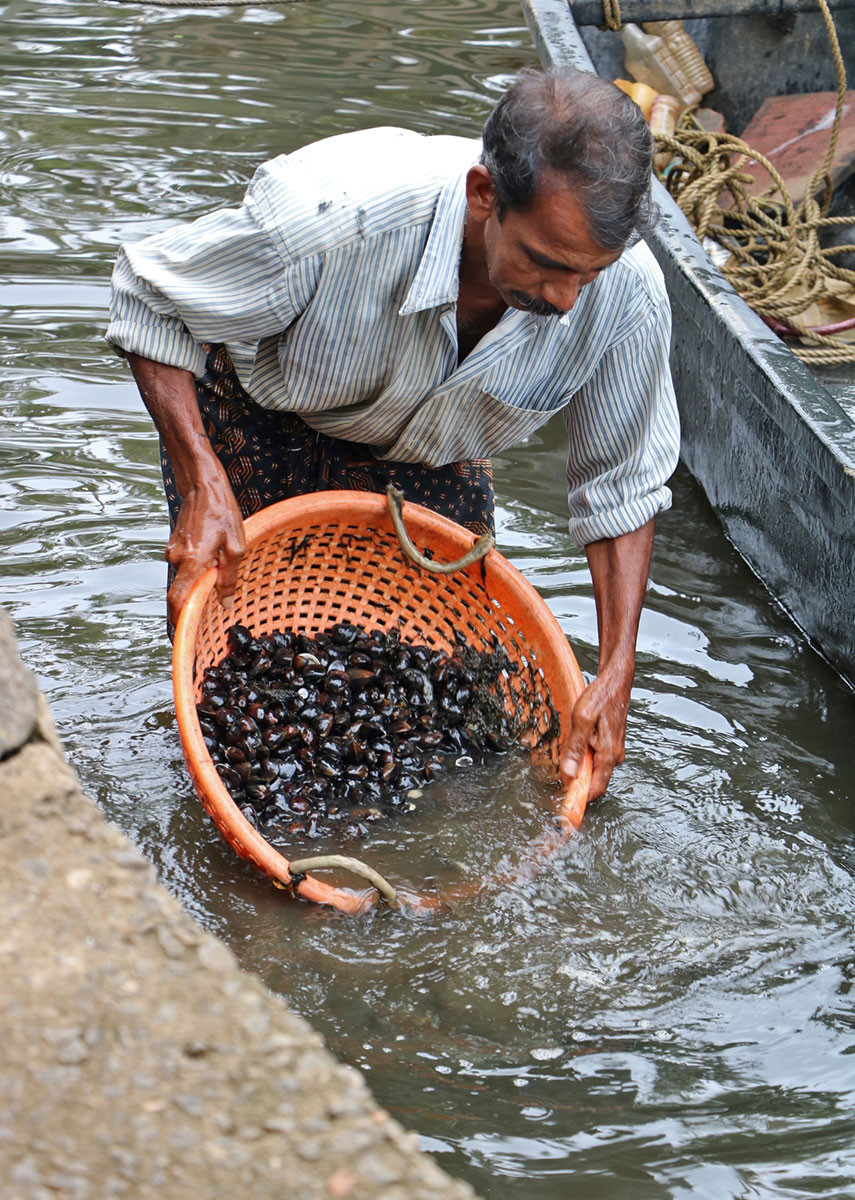This is the first story in a series of articles written by the students of Azim Premji University as part of a field practice and writing workshop for their sustainability minor.
It was still early enough in the morning that the mist blurred the division between land and backwater. Water lapped at the shore to the rhythm of passing motorboats. Behind us, the small, cramped neighbourhood was wide awake. As the boats bobbed to a stop at a small pier, women and children came up with wheelbarrows and woven baskets to relieve them of their load. While they scooped out hundreds of clams, shiny and black, others in the family were already starting up the fire over which the fresh clams would be boiled alive.
Around 5000 people living near the Vembanad Lake in Alappuzha, Kerala, depend on Black Clams (Villorita cyprinoides) for their livelihood. Interestingly, due to the high calcium content in their shells, clams are considered a mineral resource and do not fall under the Fisheries department. Their harvesting is regulated by clam collection societies licensed under the Mines and Minerals Act, 1957. This means that there is little government involvement in regulating the industry. But the collectors do have to pay a royalty to the government for harvesting the resource. For a membership fee, clam societies provide clam harvesting licences, pensions and bonuses and act as a bridge between individuals and the government.
Clam collection is a popular occupation, especially among people from more impoverished sections of society, such as the Dheerava community. Unlike fishing, clam collection provides an assured source of income―the day-to-day harvest might differ in quantity and quality, but there will always be enough to earn a living. However, in recent years, the clam population in the lake has been steadily declining. At the same time, since the COVID-19 pandemic forced a large section of people back to agriculture, fishing and clam collection, the number of people dependent on clams as a source of livelihood has been increasing.
Black Clams can live in both fresh and brackish water, but their breeding is triggered by factors like temperature and salinity, making them very vulnerable to changes in the ecosystem. Ever since the Thanneermukkom Bund started functioning in 1974, the breeding patterns of clams in Vembanad Lake have been severely affected, leading to reducing populations. Back in the 70s, the fisherfolk and clam collectors of Alappuzha were not organised enough to fight against the commissioning of the bund, unlike the communist-backed farmers campaigning for Thanneermukkom.
In a complex vicious cycle, owing to a much smaller clam population, collectors are forced to harvest even juvenile clams, which further reduces the population growth rate. Even moving to other occupations may not be a solution—the rising levels of pollution in the lake due to increasing tourist activity and the use of agricultural pesticides and fertilisers to increase productivity are contributing to a decline in fish and clam biodiversity.
Clam collection might provide a fairly secure livelihood, but that does not necessarily mean safe or decent. Clams bury themselves about fifteen to thirty centimetres in the lakebed, filtering out algae, plankton and other organic matter from the water to eat. Traditional harvesting methods involve diving into the lake and using a specialised rake that has a net attached to it. The prolonged exposure to water and pollutants in the lake often results in skin and joint problems for the clam collectors.
Once harvested, the clams are carried back home, where they are boiled over a fire in order to cook the tender meat and separate it from the shells. On my visit to a clam collection village in Muhamma Panchayat, I noticed little children helping in the preparation of the fire. Clams, I was told, don’t bring in much money—a kilogram of meat earns ₹100, while 20 kilograms of shells earn just ₹50. To keep the process as cheap as possible, the collectors use cheap burning materials for the fire, such as rubber and spare bits from the coir-making industry. These materials contain carcinogens and harmful chemicals, which according to locals, explains the increasing incidence of cancer and respiratory problems within the community. Considering that clam collection is a family enterprise, the men, women, and children inhale these toxic fumes daily for years on end.
Once boiled, the clams are sieved energetically through a large screen to separate the shells from the tender meat. Nothing is wasted―the meat is sold to homes, while the shells are sold to construction sites and farmers as fertilisers or soil acidity balancers. I saw piles of discarded shells beside every house in the neighbourhood, drying in the sun like heaps of empty mouths. In the past, they would be left outside for long periods until the shells turned white, at which point they could be ground up and sold as lime. Now there are chemical processes that allow for the direct use of the black shells without waiting for this colour change.
When asked whether he could avoid catching juvenile clams, a clam collector answered, “I know how to avoid it—the rake we use can be adapted to pull in clams only of a certain size. But if I find small clams, I’ll harvest them. After all, I need to survive. The number of clam collectors has increased so much that the only clams that survive to form the next generation are the ones that I [or other collectors] can’t find.” Often, baby clams are left out of the water to decay, then powdered and sold as poultry feed because of their high calcium content. There is no time to waste; if you don’t harvest to give them a chance to mature and breed, someone else will.
Earlier, clam collection used to be a woman's occupation. Clams were so plentiful that boats weren’t necessary to find them—one could simply dig them up from the shallows. As time went on, it became necessary to go out deeper to find them. Diving was replaced by raking, until eventually only those collectors who possessed an outboard motor could find clams. Clam societies are in a desperate race against greed—modern equipment such as a vacuum-like device to suck up huge amounts of clam at once have been banned by the societies so as to not over-exploit the resource and leave thousands jobless. They have also decreed lower limits on the size of clams that can be harvested. However, despite the threat of penalties like revoking pensions and even their licences, illegal clam collection is still rampant. Women might be the worst affected by these changes as they have fewer opportunities for alternative employment.
Clam collectors are stuck in a cycle of consumption and depletion because they, as individuals, cannot see the bigger picture. The dilemma is that unless they can trust every other person to adhere to the rules of sustainable collection, it is not profitable for just them to follow the rules. In such a complex ecosystem, the interconnectedness between sectors and systems has vital consequences. Without an external party to enforce these rules, clams may soon be harvested to extinction, and the collectors will be left hunting for other ways to survive.
We would like to thank the Ashoka Trust for Ecology and Environment (ATREE) for facilitating the field practice and Krishna Anujan for conducting the writing workshop.
References:
- Identification and evaluation of ecosystem services provided by clam (Villorita cyprinoides) fisheries in wetland
- Kerala: New project to revive clam deposit | Deccan Chronicle
- Vembanad’s fishing community protects their fish with sanctuaries | Mongabay India
- Clam collectors facing uncertain future | The Hindu
- Vembanad Lake fish count indicates decline in backwater salinity: Study | The New Indian Express
- Boost to clam stock in Vembanad Lake | The Hindu
- Mineral Resources – Department of Mining and Geology (kerala.gov.in)
- Illegal black clam harvesting triggers concern at Vembanad in Kerala | The Hindu
- Vembanad Lake fish count indicates decline in backwater salinity: Study | The New Indian Express







